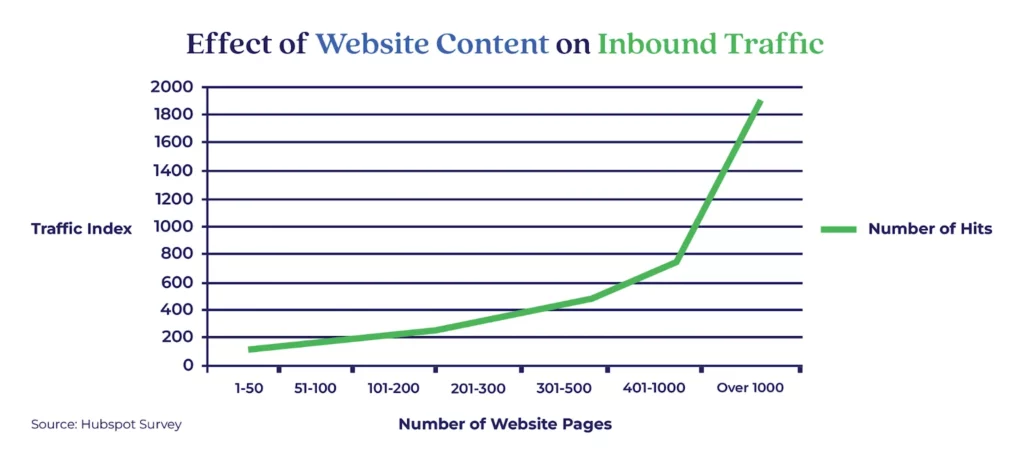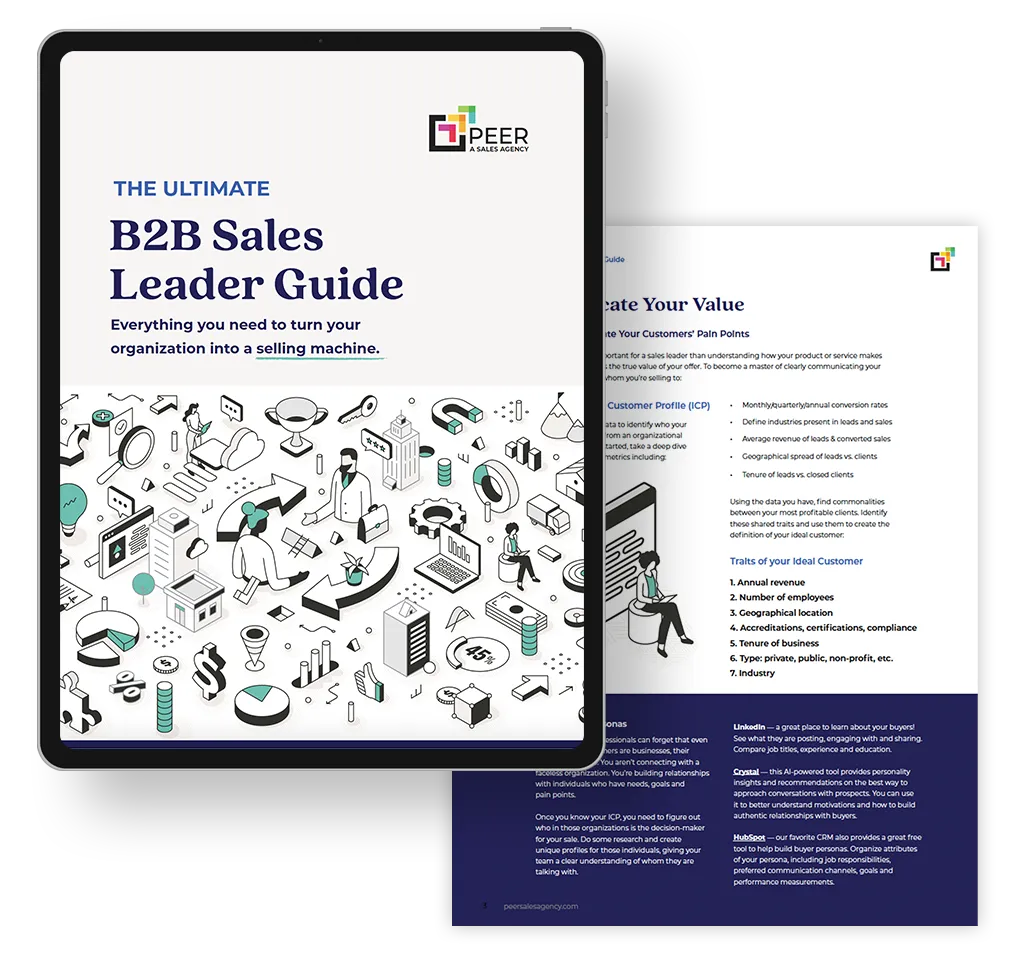As a business owner, it can be challenging to see how something like a blog article can play a role in your growth goals. And, you are not alone. I know a lot of sales leaders and CEOs that I constantly have to remind about why their blogs are important.
One objection we commonly hear is, “How does my blog help me with revenue?” or “Why is blogging necessary”? It’s fair to wonder about the purpose of blogging, so let’s break it down.
Yes, ROI can be a challenge to measure, and the results are not immediate. But the truth is, that blogging can be super valuable for your business. Over time, blogs will help you build your brand, establish authority in your industry, and connect with your audience. They are a great strategy for driving organic traffic (the kind you don’t have to pay for) to your website and yes — even generating leads. Believe it or not, blogging outperforms email marketing, social media, and paid advertising when it comes to cost and ROI.
What role do blogs play in B2B sales?
Blogging has come a long way from the bad rap of the mommy blogger. We’ve seen stats as high as 91% of B2B businesses using a blog to support their content marketing. Blogging is more than just sharing company insights or the latest news; it’s about building awareness, building relationships, and offering real value that resonates with your audience. Not only can it help you attract high-quality leads, but it can help your sales team gently guide those leads to the finish line. And often with very little work on their part.
Read: Why Content Marketing Should Be a Key Part of Your Sales Strategy
Blogs increase traffic to your website
Everyone could use more eyeballs on their website. Yet not all traffic is created equal. Blogs may just be one of the sneakiest ways to attract exactly who you want on your site.
We’ve seen first-hand with our clients, that the more blogs you have on your site, the more visitors you’ll attract. It’s a direct correlation — as blog numbers go up, so do visitors.

Here’s why: search engines love B2B blogs. Especially ones that are written well and chock full of relevant keywords and advice people are searching for. If you are clued in on who your target audience is, and you have legitimate input on how to help them, the search engines are like dating apps just waiting to match you up.
And with a little bit of planning, you can structure your blog to lead a reader onto the next step in their buyer journey. Plus, internal and external links in your blogs help improve your SEO performance. It’s like building a little web of connections that search engines can’t resist.
Read: The Ultimate Guide to Using Sales Collateral for Every Stage of the B2B Buyer’s Journey
Blogs improve your website’s position in search rankings
Blogs play a crucial role in enhancing your website’s visibility and rank on search engines, a factor that is ever so important in a digital-first marketplace. Considering that 90% of B2B purchasers initiate their buying process with an online search, appearing prominently in search results can significantly impact your business’s ability to attract and engage potential customers. Here’s how blogs play to the search engines:
- Content Freshness: Search engines, such as Google, prioritize websites that frequently update their content. Regular blog posts signal to these search engines that your site is active, providing fresh content, and therefore, more likely to be relevant to searchers’ queries.
- Keyword Optimization: B2B Blogs offer the perfect platform to incorporate target keywords strategically into your website’s content. It can be hard to get all the keywords you need into a few single pages of your website. But every blog is essentially a unique landing page for a small subset of relevant keywords.
- Enhanced User Engagement: Quality educational content can increase the time visitors spend on your website, which is a positive signal to search engines.
- Inbound Linking: Blogs are one of the most shared types of content. When someone else links to your article, you get bonus points with the engines. Inbound links act like votes of confidence from other sites, indicating to search engines that your content is valuable and trustworthy.
- Long-Tail Keyword Opportunities: Blogs allow you to explore topics in-depth, giving you the chance to incorporate long-tail keywords that are less competitive but highly targeted. These keywords often correspond to more specific queries, capturing users further down the buying funnel and closer to making a purchase decision.
B2B blogs can help you build credibility, trust, and relationships
Building trust in a B2B partnership takes time and effort, and one way to do that is by showing that you understand your client’s business, challenges, and goals. Regular, educational content allows your business to showcase its knowledge and expertise in your industry. By addressing common challenges, offering solutions, and sharing industry trends, you position your company as a thought leader, building credibility among your audience.
Blogs also give B2B companies a unique opportunity to offer value to prospects before they enter the sales funnel. By producing relevant content that answers key questions, solves problems, and provides actionable insights, you’re helping potential clients without asking for anything in return. This generosity of knowledge fosters trust and goodwill, key components of any strong business relationship. B2B buyers typically read between 3 to 5 blog posts before engaging with a sales agent. So you have to consider if your target customer is out there reading blog articles and you don’t offer them, whose blogs are they reading? Your top competitors?
Blogs can help buyers overcome objections
Buyer objections are often rooted in concerns about product fit, value, implementation, or cost — and they can significantly impede the sales cycle. Through targeted and insightful blog content, you can preemptively address and alleviate these concerns, smoothing the path to a successful sale.
Many buyer objections arise from a lack of understanding or misinformation about the product or service. B2B Blogs can educate prospects on the nuances of your offerings, how they work, their benefits, and their competitive edge.
Buyers also hesitate because they can’t visualize how a product or service fits into their operations or solves their specific problems. Through blog articles that detail case studies, success stories, and real-life applications, you can demonstrate practical examples of how your solutions have effectively addressed similar challenges.
By having objections readily available on your blog, you’re giving prospects the chance to find answers to their questions on their own. This means you won’t miss out on a deal just because they didn’t want to bring up those objections in a face-to-face conversation.
B2B blogs help to shorten the sales cycle
Navigating the notoriously lengthy B2B sales cycle can be a daunting challenge for many businesses. With complex decision-making processes and multiple stakeholders involved, these extended timelines can significantly impact a company’s growth and revenue. However, incorporating a strategic blogging approach offers a promising solution to alleviate some of these frustrations.
Read: Win more deals by educating prospects with a killer blogging strategy
Blogs have the unique ability to educate and nurture potential clients from the very beginning of their buying journey. By delivering valuable insights, addressing industry pain points, and offering in-depth details about your solutions, blogs can significantly demystify your offerings. This preemptive education ensures that by the time prospects engage with your sales team, they are already well-informed, making them more prepared and likely to make decisions faster.
Furthermore, by building trust and establishing credibility through consistent, authoritative content, blogs help forge a stronger connection with your audience. This trust is crucial in shortening the B2B sales cycle, as prospects who trust your brand are more likely to move through the decision-making process with confidence and speed.
Moreover, the targeted nature of blog content helps attract more qualified leads. Readers who find value in your posts are likely more aligned with your solutions, meaning the leads that do come through are warmer and more inclined to progress through the sales funnel more quickly.
How to create B2B blogs that work for you.
In wrapping up our exploration of what makes blogs truly engaging and how they can powerfully support your sales cycle, it’s essential to underscore two fundamental principles: speaking directly to your audience and consistently delivering value. These elements are the linchpins of captivating content that not only grabs attention but also holds it.
To create valuable content that resonates, it’s vital to understand and directly address the needs, interests, and challenges of your audience. This approach ensures that your articles are not just seen but felt, fostering a deeper connection with your readers. Coupled with this personalized approach is the imperative of delivering tangible value. Whether through insightful analysis, actionable advice, or innovative solutions, the content that stands out is the content that enriches your audience’s knowledge and empowers them to act.
Remember, blogs serve as versatile tools in supporting the sales cycle, each type playing a unique role in the buyer’s journey. SEO blogs stand at the forefront, attracting qualifed leads by aligning with their search queries. These blogs are crucial in helping potential clients recognize the problem they seek to solve, and warming them up for deeper engagement.
Beyond attraction, blogs also play a pivotal role in moving prospects down the funnel. They act as sales enablement tools, providing your sales team with timely touchpoints that showcase the company’s expertise, address common objections, and navigate the complexities of multi-stakeholder approval processes. Furthermore, through sharing success stories and testimonials, blogs offer persuasive narratives that demonstrate the tangible benefits and successes other clients have achieved with your solutions.
In essence, the power of a great article lies in its ability to speak directly to your target audience and deliver value at every turn. By leveraging the distinct strengths of blogs and content designed to move prospects through the sales funnel, you can create a cohesive, engaging content strategy that not only supports the sales cycle but accelerates it, driving growth and building lasting relationships with your ideal buyers.




